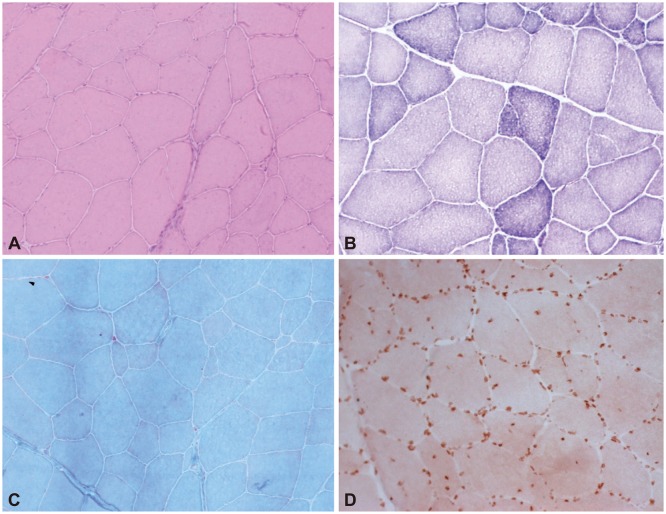J Clin Neurol.
2017 Oct;13(4):405-410. 10.3988/jcn.2017.13.4.405.
Early-Onset LMNA-Associated Muscular Dystrophy with Later Involvement of Contracture
- Affiliations
-
- 1Department of Neurology, Yonsei University College of Medicine, Seoul, Korea. ycchoi@yuhs.ac
- 2Department of Neurology, Mokdong Hospital, Ewha Womans University School of Medicine, Seoul, Korea.
- 3Rehabilitation Institute of Neuromuscular Disease, Yonsei University College of Medicine, Seoul, Korea.
- KMID: 2392137
- DOI: http://doi.org/10.3988/jcn.2017.13.4.405
Abstract
- BACKGROUND AND PURPOSE
The early diagnosis of LMNA-associated muscular dystrophy is important for preventing sudden arrest related to cardiac conduction block. However, diagnosing early-onset Emery-Dreifuss muscular dystrophy (EDMD) with later involvement of contracture and limb-girdle muscular dystrophy type 1B is often delayed due to heterogeneous clinical presentations. We aimed to determine the clinical features that contribute to a delayed diagnosis.
METHODS
We reviewed four patients who were recently diagnosed with LMNA-associated muscular dystrophy by targeted exome sequencing and who were initially diagnosed with nonspecific or other types of muscular dystrophy.
RESULTS
Certain clinical features such as delayed contracture involvement and calf hypertrophy were found to contribute to a delayed diagnosis. Muscle biopsies were not informative for the diagnosis in these patients.
CONCLUSIONS
Genetic testing of single or multiple genes is useful for confirming a diagnosis of LMNA-associated muscular dystrophy. Even EDMD patients could experience the later involvement of contracture, so clinicians should consider early genetic testing for patients with undiagnosed muscular dystrophy or laminopathy.
MeSH Terms
Figure
Reference
-
1. Bonne G, Di Barletta MR, Varnous S, Bécane HM, Hammouda EH, Merlini L, et al. Mutations in the gene encoding lamin A/C cause autosomal dominant Emery-Dreifuss muscular dystrophy. Nat Genet. 1999; 21:285–288. PMID: 10080180.
Article2. Emery AE. Emery-Dreifuss muscular dystrophy-a 40 year retrospective. Neuromuscul Disord. 2000; 10:228–232. PMID: 10838246.3. Bonne G, Mercuri E, Muchir A, Urtizberea A, Bécane HM, Recan D, et al. Clinical and molecular genetic spectrum of autosomal dominant Emery-Dreifuss muscular dystrophy due to mutations of the lamin A/C gene. Ann Neurol. 2000; 48:170–180. PMID: 10939567.
Article4. Sewry CA, Brown SC, Mercuri E, Bonne G, Feng L, Camici G, et al. Skeletal muscle pathology in autosomal dominant Emery-Dreifuss muscular dystrophy with lamin A/C mutations. Neuropathol Appl Neurobiol. 2001; 27:281–290. PMID: 11532159.
Article5. van der Kooi AJ, Ledderhof TM, de Voogt WG, Res CJ, Bouwsma G, Troost D, et al. A newly recognized autosomal dominant limb girdle muscular dystrophy with cardiac involvement. Ann Neurol. 1996; 39:636–642. PMID: 8619549.
Article6. Menezes MP, Waddell LB, Evesson FJ, Cooper S, Webster R, Jones K, et al. Importance and challenge of making an early diagnosis in LMNA-related muscular dystrophy. Neurology. 2012; 78:1258–1263. PMID: 22491857.
Article7. Narayanaswami P, Weiss M, Selcen D, David W, Raynor E, Carter G, et al. Evidence-based guideline summary: diagnosis and treatment of limb-girdle and distal dystrophies: report of the guideline development subcommittee of the American Academy of Neurology and the practice issues review panel of the American Association of Neuromuscular & Electrodiagnostic Medicine. Neurology. 2014; 83:1453–1463. PMID: 25313375.8. Bönnemann CG, Wang CH, Quijano-Roy S, Deconinck N, Bertini E, Ferreiro A, et al. Diagnostic approach to the congenital muscular dystrophies. Neuromuscul Disord. 2014; 24:289–311. PMID: 24581957.
Article9. Park HJ, Jang H, Kim JH, Lee JH, Shin HY, Kim SM, et al. Discovery of pathogenic variants in a large Korean cohort of inherited muscular disorders. Clin Genet. 2017; 91:403–410. PMID: 27363342.
Article10. Quijano-Roy S, Mbieleu B, Bönnemann CG, Jeannet PY, Colomer J, Clarke NF, et al. De novo LMNA mutations cause a new form of congenital muscular dystrophy. Ann Neurol. 2008; 64:177–186. PMID: 18551513.11. Ki CS, Hong JS, Jeong GY, Ahn KJ, Choi KM, Kim DK, et al. Identification of lamin A/C ( LMNA) gene mutations in Korean patients with autosomal dominant Emery-Dreifuss muscular dystrophy and limb-girdle muscular dystrophy 1B. J Hum Genet. 2002; 47:225–228. PMID: 12032588.12. Dai Y, Wei X, Zhao Y, Ren H, Lan Z, Yang Y, et al. A comprehensive genetic diagnosis of Chinese muscular dystrophy and congenital myopathy patients by targeted next-generation sequencing. Neuromuscul Disord. 2015; 25:617–624. PMID: 25987458.
Article13. Komaki H, Hayashi YK, Tsuburaya R, Sugie K, Kato M, Nagai T, et al. Inflammatory changes in infantile-onset LMNA-associated myopathy. Neuromuscul Disord. 2011; 21:563–568. PMID: 21632249.
Article
- Full Text Links
- Actions
-
Cited
- CITED
-
- Close
- Share
- Similar articles
-
- Infantile-Onset LMNA-Related Congenital Muscular Dystrophy Presenting as Torticollis: A Case Report
- Emery-Dreifuss Muscular Dystrophy with Cardiac Involvement
- Duchenne Type Muscular Dystrophy: Report of 8 Cases
- Two Cases of Oculopharyngeal Muscular Dystrophy in One Family
- Progressive Muscular Dystrophy: A Case Report



